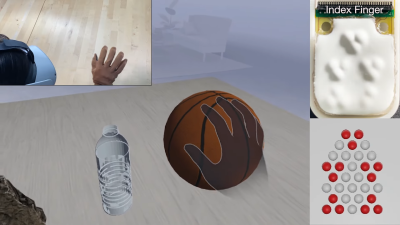Now that we have decent VR goggles, the world is more desperate than ever for a decent haptic interface for interacting with computers. We might be seeing a new leap forward in this wild new haptic glove design from the Future Interfaces Group at Carnegie Mellon University.

The glove gives each fingertip and thumb a small haptic pad. The pads are driven by electro-osmotic pumps, which are effectively solid-state. They use electricity to move fluid to create small dimples on the pad to provide haptic feedback to the user. The pads have 20 pixels per square centimeter, are quick and responsive, and can deform up to 0.5 mm in less than half a second.
The lightweight and self-contained electro-osmotic pads mean the haptic system can be far lighter and more practical than designs that use solenoids or other traditional technologies. The device is also high resolution enough that a user can feel pressure from a surface or the edges of an object in VR. If you watch the video, some of the demonstrations are quite revolutionary.
We’ve seen some other great haptics projects before too, like these low-cost force feedback gloves. Video after the break.
[Thanks to Keith Olson for the tip!]















Wow! That’s very cool! Hope they can shrink the bulky gloves into something nice and sleek.
VR is pretty cool, alas i don’t own a headset, but that is partly because i haven’t found a compelling enough experience that i want on it
My wife & I regularly play Walkabout Mini Golf together on our two Meta Quest 3 headsets, often for a couple of hours a day. We use the devices for various other things, but they would have easily been worth buying just for that absolutely glorious game (which is also fine for solo play, and you can find lots of other people online to play with if you don’t have someone local). Our second-favorite game is Synth Riders, which is essentially a solo experience. These days the issue with VR isn’t finding ways to use it, but rather having the self control to keep it from taking over your life.
Rule 34.
hahaha
I thought that was what Rule 34 pointed to and I looked it up to confirm it.
Just waiting for the full body suit, with sub millimeter resolution.
might be useful for designing a braille “display”
We already have braille display technology with devices like the braille note. Been around for decades.
yes but they’re slow, inefficient and have a small viewing area. something like this could improve a blind persons interaction with the internet immanency. with is a use case far more meaningful then vr gaming
This would really help with my new VR proctology training sim.
“the world is more desperate than ever for a decent haptic interface”
(o _ O )
It’s pretty funny because facebook spent a huge amount of money developing an anachronistic way to do the same thing:
https://www.science.org/doi/10.1126/sciadv.adl3014
They developed an absolutely steampunk approach with pneumatic logic to make things like a row column decode circuit to control a grid of pneumatic pixels. Except it’s slower, bigger, has binary rather than proportional output, uses lots of expensive piezoelectric valves, and noisy. It’s worth watching the videos just to see how loud it is.
it’s really hard to believe facebook spent so much money on this absurd approach.
Wow. It actually gives me hope for myself.